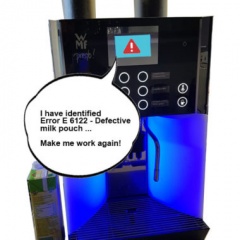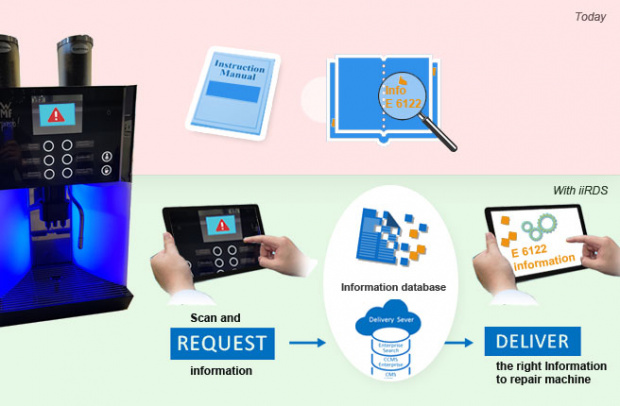iiRDS – How a Novice Sees the Information Delivery Standard
Lately, the newly developed tekom standard iiRDS has gained quite some attention. The next exciting step will be the release of version 1.0, which will be released soon. Requesting and delivering intelligent information as a standardized approach between individual enterprises is a pioneering step in the Internet of Things – but let’s rewind a little.
As a novice in the field of technical communication, let me introduce you to the world of iiRDS from my point of view.
Having recently started as an iiRDS project assistant, I’m occupied with iiRDS and everything related all day. “But … what exactly are you doing at your new job?” is a question I am frequently asked by my friends. If I may outline my previous occupation for just a moment: I studied German and English language and just finished my Master’s thesis on intercultural and transcultural work relationships. By all means, I am a novice in the field of technical communication. In this blog entry, I will try to summarize how I have come to understand the complex world of what iiRDS is and how it actually works.
Let’s Zoom in on a Machine We Use in Our Everyday Life
When you hear about iiRDS for the first time, it will probably seem quite complicated – it was the same for me.
So to understand it better, let’s strip it down to a machine everybody knows from everyday use: Why not use a coffee machine in order to explain the highly technical standard?
The first thing you need to know is that iiRDS is a standard that enables the request and delivery of intelligent information, not with the help of documents, but with tiny information bits. So, if a new coffee machine is delivered to your office, you get documentation with it – in the form of a written manual. In case of maintenance or a malfunction, like the obligatory daily cleaning or a defective milk pouch, you as a person might need a long time to read through the many pages of documentation to finally find the information on cleaning or on exchanging the defective milk pouch.
iiRDS changes this. Intelligent information means you are delivered the right information (no more and no less), right on the spot, for the concrete situation, and on the preferred mobile device, which could be a tablet, smartphone, or more futuristically, data glasses. To exchange the milk pouch, you would not have to skim through the entire manual. You would just get only the information on how to fix the milk pouch.
The coffee machine is a machine that is essential every day in the office and that probably often drives you or your colleagues crazy with its needs like “please refill milk”, “water tank empty” or “please clean the filter”. So what does iiRDS have to do with this? Let me illustrate this simply:
Today:
- See that the machine is not working
- Check why the machine is not working
- Go to the archive to look through all the stored documentation for the documentation of the machine with a malfunction
- Skim through the whole chapter of malfunctions to find the malfunction your machine has at the moment
- Go back to the machine and fix it
Tomorrow – with iiRDS:
- See that the machine is not working; error code on display
- As a service technician, scan the code of the machine with the help of an intelligent assistant on mobile device
- Wait a couple of seconds
- Get the answer delivered automatically
iiRDS Behind the Scenes
The scenario described above is accomplished via metadata. Metadata are data that contain information about other data, but not the data itself. iiRDS is a metadata model where metadata are defined and are linked in an ontology. An ontology is like a huge and very complex mind map: It defines relationships between single terms and is much more complex than a taxonomy could ever be. You guessed it: I did not know these terms before I started my job.
So, in the case of a malfunction, let’s say the milk pouch is defective and the coffee machine stops working (which, obviously, is unacceptable) – the service technician could go to the machine, scan a code attached to the coffee machine and in no time, receive the information on what exactly to do in his situation:
Metadata define the right topic out of a whole bulk of topics and establish the context between different topics. The information itself plus the metadata are then bundled into one package, which can be sent to the recipient.
Sounds Quite Futuristic – But Let Me Dig Even A Little Deeper.
Let’s widen our perspective a little bit: iiRDS works not only with coffee machines, but in different industries, for example the oil, energy, chemical and pharmaceutical industries, among others. Furthermore, iiRDS works independently among all the various undertakings of those diverse industries.
- How does it bring all those industries with their different systems together?
- Do companies need to restructure entire systems they have worked with for many years just to be able to use the advantages of iiRDS?
The simple answer is: No.
The second answer is: This is exactly why the iiRDS standard is required. This is illustrated by the fact that, in one company, instructions for use might be called “instructions for use” but, in another company, the same thing might be called a “user guide” or even a “user manual”. iiRDS offers a standardized vocabulary without companies having to adjust their terms – they only need to map their term to the one defined in iiRDS – and they only need to do it once. Simply by doing so, the exchange of information among various agreements is enabled, and work efficiency can be increased to a whole new level.
Now that you’ve read this: How far do you imagine we can go with this?
As a matter of fact, this format could be how intelligent information request and delivery will work in the future. In these times of smart factories and the Internet of Things, this standard opens up new ways of advanced technical communication. Being on board means being a pioneer in one of the most exciting fields of our time, Industry 4.0.
This article was originally published on the "intelligent information" tekom blog.
More on the subject
- Ulrike Parson: iiRDS - der aktuelle Stand zur tekom-Herbsttagung 2017
- Ulrike Parson: iiRDS - der neue Auslieferungsstandard für die Technische Dokumentation
- Mark Schubert: RDF is not XML - RDF serialization and iiRDS metadata




